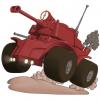So I spent most of last year learning Unity and I got really good at it, but I always wanted to get Unreal Engine 4, and I finally did this year. Its been so difficult to make the transition to UE4 since I was so trained in Unity. Does anyone have this issue and a solution to master UE4? I feel like the problem with Epic, is their reliance on the Blueprints so much, anything you want to do needs a little bit from the blueprints, even something like using a different texture for your terrain environment, unlike Unity which has the slots you can add textures in to.
I watched the first 2 videos on Blueprints from Epic, and I stopped after the second because the information is so outdated, I couldn't follow along with any thing they were doing because I use 4.7 and they used an earlier version, not very backward compatible if you ask me.
So how does one go about learning Unreal? Is their a good youtube series you can recommend?








